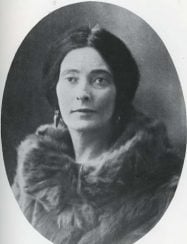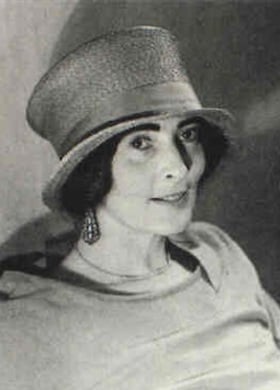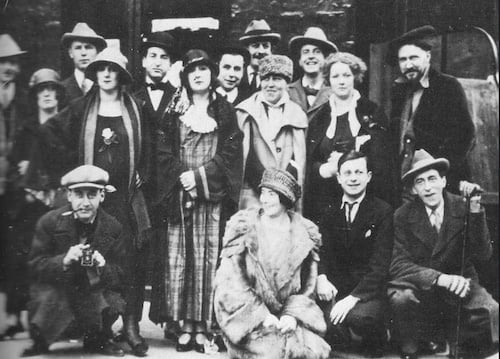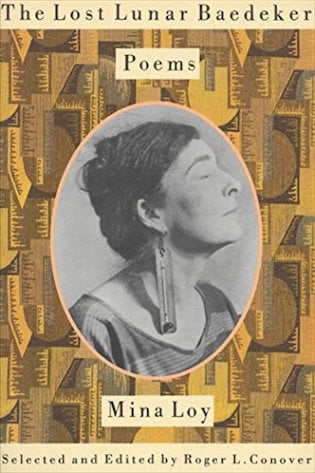Mina Loy, Modernist Poet, Playwright, and Artist
By Taylor Jasmine | On May 18, 2021 | Updated October 13, 2024 | Comments (0)

Mina Loy (December 27, 1882 – September 25, 1966) was a brilliant English-born poet, playwright, and artist. Light years ahead of her time, she was lauded by her peers for her dense analyses of the female experience in early twentieth-century Western society.
She was associated with other great minds and literary innovators of her time, like T.S. Eliot, William Carlos Williams, Marianne Moore, Sylvia Beach, Sinclair Lewis, Ezra Pound, and others.
Background
Loy was born Mina Gertrude Löwy in London, England, the eldest daughter of Sigmund and Julia Bryan Löwy. Löwy’s father was a Jewish-Hungarian immigrant.
Mina was granted an unconventionally thorough education for a young lady of a wealthy middle-class family, traveling to Europe to study in the great art capitals of the Continent.
Unhappy marriages and a peripatetic life
At twenty-one, Loy married fellow artist Hugh “Stephen” Oscar William Haweis. They settled in Paris among the bustling modernist art salons, where they mingled with the likes of Guillaume Apollinaire, and Picasso, as well as Leo and Gertrude Stein.
Loy and Haweis had three children. Their eldest, Oda Janet, died in infancy. The bereaved family relocated to Florence, Italy, where Loy gave birth to two more children, Joella and Giles. Loy began to suffer from frequent ailments and mental illness, but continued to pursue and exhibit her art in both Italy and her native England.
As a young child, Joella was unwell, leading to Loy’s pursuit of Christian Science. Her marriage to Haweis was never a happy one, and in 1913, he abandoned his family to travel to the South Seas. The couple finally divorced several years later. Loy spent these years as a recluse among the expatriate community in Florence, a sad and beautiful young woman — unprepared for motherhood, overwhelmed by her illnesses and Joella’s.
Despite her own afflictions, Loy worked as a nurse during World War I but soon abandoned the Continent for the United States. In October 1916, she left her children in the care of a nurse, intending to retrieve them soon, and sailed for New York City.
While in New York, Loy fell in love with early Dadaist and surrealist, Arthur Cravan. In January 1918, they married in Mexico City, then returned to Europe to reunite with Loy’s children and make a home in Paris. Loy went ahead, planning to reunite with Cravan in Buenos Aires, Argentina, but he never arrived.
Loy diverted her travels to London, where she gave birth to their daughter, Jemima Fabienne. Cravan’s disappearance devastated Loy, and she would continue to mourn him in her writings. In 1921, Loy’s ex-husband abducted their son Giles from Florence. The child died only two years later.
She settled again in Paris, this time with her daughters, and together they ran a business where she designed and sold lampshades.
. . . . . . . . . .

. . . . . . . . . .
Becoming a poet
Though Loy began her art career with painting, her creative fire propelled her expansion into other forms of artistic expression. Her introduction to Italian futurists, Carlo Carrà, F.T. Martinetti, and Giovanni Papini among them, was a primary inspiration to her poetry.
Although she espoused the futurists’ teachings on how to use one’s “vitality,” Loy remained skeptical of their machismo and quickly turned to satirize them in pamphlets, poems, and plays like “The Sacred Prostitute,” Psycho-Democracy, and “Lions’ Jaws.”
In New York City, Loy was recognized as the epitome of the avant-garde woman. She was a forerunner of the movement to modernize poetry inspired by futurism, cubism, and surrealism. Immediately after her arrival in the States, Loy acted in Kreymborg’s play, Lima Beans.
Loy was too radical for the more mainstream poetry journals of her day but found a home for her work in journals such as Others, Camera Work, and Rogue. After Marcel Duchamp’s definitive Dadaist sculpture was rejected by the New York Independents Exhibit, Duchamp, Loy, and others collaborated on a journal of their own, called Blind Man.
Feminist Manifesto
Feminist Manifesto, which is now considered Loy’s greatest work, wasn’t published until decades after her death. In this 1914 piece, Loy vehemently lays out her belief that women needed to assert their own special brand of selfhood because they had so long been relegated to subsuming their personalities and desires to those of men.
The undercurrent is Loy’s struggles with modernism — the artistic philosophy of her day — and its central aesthetic of impersonality.
. . . . . . . . . .

Mina Loy was central to a group of creatives known as “The Crowd”
. . . . . . . . . .
Visual arts
Loy was as much noted for her visual art as for her writing. She was promoted by the noted art dealer Peggy Guggenheim, who wrote,
“Mina Loy, who was not only a poetess and a painter, was always inventing something new by which she hoped to make a fortune. She had just created a new, or old, form of papier collé – flower cut-outs which she framed in beautiful old Louis Philippe frames she bought in the flea market. She asked me to take these to New York for her and sell them.”
Peggy exhibited Loy’s work in her Madison Avenue gallery, with great success. Later, back in Paris, Mina and Peggy went into business together, opening a lampshade shop.
Controversy and legacy
Mina Loy’s shockingly open handling of sexuality scandalized more conservative readers and her cerebral, abstract style alienated and confused many, but her supporters praised her “dance of the intelligence among words and ideas” and her innate artistry, saying, “Yes, poetry is in this lady whether she writes or not.”
Loy sought to combine feminism and futurism, often to unsettling ends. She asserted that intelligent women ought to produce children as part of “race-responsibility,” as she expressed in her Manifesto. This hinted at a eugenicist way of thinking.
She railed against the ideal of virginity and how it constrained women to narrowly defined roles set for them by men. Her assertion in the Manifesto that girls should have their virginity destroyed by surgery when they reach puberty continues to disturb.
Still, her unabashed honesty and demands that her readers face their own truth, never shrinking to hide in delusion, capture the terrible beauty of life’s constant change. Her short lines and not-quite-free verse style reflected the deep emotion and deep thought saturating her poetry. Her bounding from imagery to calculated analysis irked some of her fellow artists but was an intentional artistic reflection of the chaos of the physical world and our own inner processes.
. . . . . . . . .

More about Mina Loy
On this site
- Mina Loy’s Feminist Manifesto
- Mina Loy and “The Crowd” — Modernists in 1920s Paris
- That is the New Rhythm: Mina Loy and Marianne Moore
- “Love Songs” by Mina Loy (1915)
Poetry
- Lunar Baedeker (1923)
- Lunar Baedeker and Time-Tables (1958)
- The Last Lunar Baedeker, Roger Conover, ed. (1982)
- The Lost Lunar Baedeker, Roger Conover, ed. (1997)
Prose
- Insel, Elizabeth Arnold ed. (1991)
- Stories and Essays, Sara Crangle, ed. (2011)
More information
Read online
- Mina Loy at Electronic Poetry Center
- Works by or about Mina Loy at HathiTrust
- Works by or about Mina Loy at Internet Archive
Leave a Reply